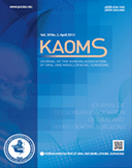Journal of the Korean Association of Oral and Maxillofacial Surgeons
- P-ISSN2234-7550
- E-ISSN2234-5930
- SCOPUS, KCI, ESCI
 ISSN : 2234-7550
ISSN : 2234-7550
Single-insertion technique for anesthetizing the inferior alveolar nerve, lingual nerve, and long buccal nerve for extraction of mandibular first and second molars: a prospective study
Kumar Nithin (Department of Oral Surgery, Dental Faculty, Tishk International University, Erbil, Iraq)
Vyloppilli Suresh (Department of Oral and Maxillofacial Surgery, Malankara Orthodox Syrian Church Hospital and Medical College, Ernakulum)
Sayd Shermil (Department of Oral and Maxillofacial Surgery, Kannur Dental College, Kannur, India)
Manojkumar KP (Department of Oral and Maxillofacial Surgery, Kunhitharuvai Memorial Charitable Trust (KMCT) Dental College, Calicut, India)
Vijaykumar Depesh (Department of Oral and Maxillofacial Surgery, Kunhitharuvai Memorial Charitable Trust (KMCT) Dental College, Calicut, India)
Abstract
Objectives: Appropriate and accurate local anesthetic (LA) techniques are indispensable in the field of oral and maxillofacial surgery to obtain a satisfactory outcome for both the operating surgeon and the patient. When used alone, the inferior alveolar nerve block (IANB) technique requires supplemental injections like long buccal nerve block for extraction of mandibular molars leading to multiple traumatic experiences for the patient. The aim of this study was to anesthetize the inferior alveolar, lingual, and long buccal nerves with single-needle penetration requiring a minimal skillset such as administering a conventional IANB through introduction of the Benny Joseph technique for extraction of mandibular molars. Materials and Methods: This was a prospective study conducted in the Department of Oral and Maxillofacial Surgery, Kunhitharuvai Memorial Charitable Trust (KMCT) Dental College, Calicut, India. The duration of the study was 6 months, from June to November 2017, with a maximum sample size of 616 cases. The LA solution was 2% lignocaine with 1:100,000 adrenaline. The patients were selected from a population in the range of 20 to 40 years of age who reported to the outpatient department for routine dental extraction of normally positioned mandibular right or left first or second molars. Results: Of the 616 patients, 42 patients (6.8%) required re-anesthetization, a success rate of 93.2%. There were no complications such as hematoma formation, trismus, positive aspiration, and nerve injuries. None of the cases required re-anesthetization in the perioperative period. Conclusion: The Benny Joseph technique can be employed and is effective compared with conventional IANB techniques by reducing trauma to the patient and also requires less technique sensitivity.
- keywords
- Benny Joseph technique, Lingual nerve block, Inferior alveolar nerve block, Long buccal nerve block
- 40Downloaded
- 150Viewed
- 0KCI Citations
- 0WOS Citations